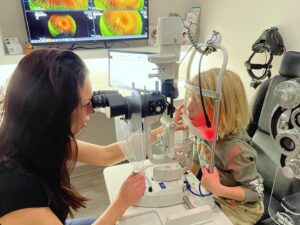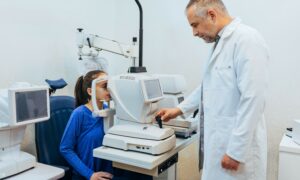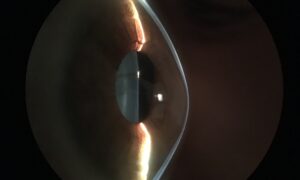June 3, 2024
By Sheila Morrison, OD, MSc, FSLS, FAAO
By conducting thorough eye exams, educating parents on management options, engaging in detailed discussions, and considering the child’s lifestyle and preferences, we can help parents make informed decisions.
Myopia necessitates a methodical and evidence-based approach from eye care providers to guide parents through the management decision-making process. As eye care professionals, our responsibilities extend beyond the diagnosis; we also educate and support parents in understanding and selecting the most appropriate myopia management options for their children. This process can be complicated or daunting for some practitioners, but over time, I’ve been able to break down the best ways to help guide parents through the myopia management decision with the following nine steps:
Step 1: Explain What Is At Risk If No Treatment Option is Taken
It is crucial for parents to understand the eye health risks associated with myopia and the importance of myopia control to motivate their engagement in treatment plans. However, it is equally important to convey this information without inducing undue anxiety about their child’s ocular and vision health. Begin discussions by acknowledging that while their child is nearsighted, there are now effective treatment programs that can decelerate the rate of progression. This approach minimizes the severity of myopia and reduces the risk of developing serious, sight-threatening ocular diseases. Focus on introducing the options for control and detailing the practical requirements of each method, avoiding jargon-heavy explanations of the underlying science.
Step 2: Be Prepared with a Simplified Myopia Explanation
A sample script to use with parents could look like this:
Myopia, characterized by the ability to see close objects clearly while distant objects appear blurry, typically develops in childhood, and progresses until early adulthood. Higher levels of myopia are associated with a higher risk for retinal detachment, glaucoma, and macular degeneration. It is best to provide myopia management options as early as possible, as these are likely to slow or halt myopic progression during some growth periods.
Step 3: Conduct a Comprehensive Eye Exam and Myopia Management Work-Up
The foundation of myopia management begins with a thorough eye examination including anterior and posterior ocular health. Utilize visual acuity tests, retinoscopy, and refraction assessments to diagnose myopia accurately. Emphasize to parents the critical importance of regular eye exams, as early detection and ongoing monitoring are essential for effective myopia management. Consider the following additional baseline measurements to assess risk for myopia progression and candidacy for therapeutic options: cycloplegic refraction, axial length (a-scan or biometry), corneal topography, and binocular vision screening.
Step 4: Educate About Myopia Management Options
Providing parents and caregivers with a comprehensive understanding of myopia management options is essential.
Key management strategies include:
- Optical Therapies
- Next-Generation Myopia Control Spectacles
- Daily Wear Contact Lenses
- Nightly Wear Orthokeratology Lenses
- Pharmaceutical Intervention (low-dose atropine)
- Lifestyle and Environmental Changes
Novel management strategies discussed in the literature include but may not be limited to:
- Light Therapies
- Red light
- Violet light
Step 5: Engage in a Detailed Discussion with Parents
Engage parents in a detailed discussion about the available management options, customized to their child’s specific needs and lifestyle. Use this opportunity to address their concerns, answer questions, and provide personalized recommendations. Remember to set the expectation that the goal of myopia control therapies is to reduce the cumulative lifetime myopia progression rate; this may not be linear, and children are expected to grow in refraction and axial length at a relatively more normative rate with myopia control than without. Emphasize the importance of a collaborative approach in selecting the most suitable myopia management strategy.
Step 6: Highlight the Benefits and Risks, Address Safety Concerns About Treatment Options
Clearly articulate the benefits and potential risks associated with each myopia management option. Ensuring parents have a balanced view will facilitate informed decision-making. Safety is a paramount concern for parents considering myopia management options for their children. Address these concerns comprehensively to build trust and confidence in the recommended treatments. Discuss common safety concerns for each treatment option:
- Daily or Nightly Wear Contact Lenses: Highlight the rigorous testing and safety standards these lenses undergo. Emphasize the importance of proper handling and care. Provide evidence-based literature to show that contact lenses are safe and effective when used correctly.
- Low-Dose Atropine Drops: Provide detailed information on the safety profile of atropine drops, including potential side effects and the (low incidence) of adverse reactions. Discuss current off-label use and compounded formulations versus future on-label and commercially manufactured atropine.
- General Safety Measures: Advise parents and caregivers on the importance of regular follow-ups to monitor their child’s response to the treatment and to make any necessary adjustments. Encourage them to report any concerns or unusual symptoms promptly.
Step 7: Consider the Child’s Lifestyle and Preferences
Assess the child’s lifestyle and preferences to determine the most suitable myopia management approach. For active children involved in sports, contact lenses may be preferable to glasses. For children uncomfortable with contact lenses, low-dose atropine drops or glasses might be more appropriate. Tailoring the management plan to the child’s daily activities and comfort level is crucial for adherence and effectiveness.
Step 8: Develop a Follow-Up Plan
Stress the importance of regular follow-up appointments to monitor myopia progression and adjust the management plan as needed. Typically, biannual follow-ups are recommended, but the frequency may vary based on individual circumstances. Reinforce to parents that myopia management is an ongoing commitment requiring continuous monitoring and potential adjustments.
Step 9: Foster Continuing Education and Support
Myopia control literature and care standards are constantly evolving. Encourage parents to stay informed about the latest research and advancements in myopia management. Recommend reputable sources and support groups where they can share experiences and gain additional insights. Emphasize the importance of open communication with their child to ensure the management plan remains effective and well-tolerated.
Guiding parents through the myopia management decision-making process is a multifaceted responsibility for eye care providers. By conducting thorough eye exams, educating parents on management options, engaging in detailed discussions, and considering the child’s lifestyle and preferences, we can help parents make informed decisions. Regular follow-ups and fostering ongoing education and support are essential components of effective myopia management. We can improve long-term ocular health and overall whole-human outcomes for children through a proactive and collaborative approach.
 |
Dr. Sheila Morrison is a private practice clinician and educator. She earned her Doctorate of Optometry and Masters Degree in Vision Science (with a focus on scleral lenses), along with a Residency in Cornea and Contact Lens from Pacific University College of Optometry. After serving on faculty at the University of Houston College of Optometry as a clinical professor and director of the University Contact Lens and Cornea clinic, Dr. Morrison joined Mission Eye Care, where she is a faculty supervisor for the Mission Eye Care Residency in Cornea and Contact Lens and also adjunct faculty at NSU Oklahoma College of Optometry. She publishes and lectures both nationally and internationally on myopia management, contact lenses, and dry eye. Her clinical research interests are currently focused on technologically driven contact lens design for orthokeratology, scleral, corneal, and custom soft contact lenses. She is a fellow of the American Academy of Optometry and the Scleral Lens Education Society. |














